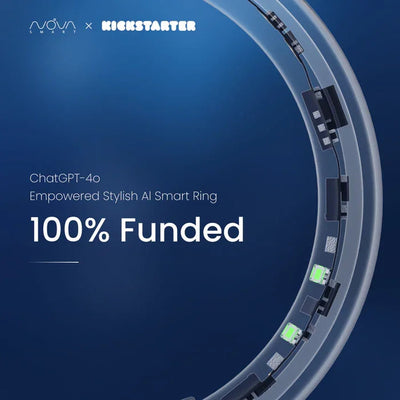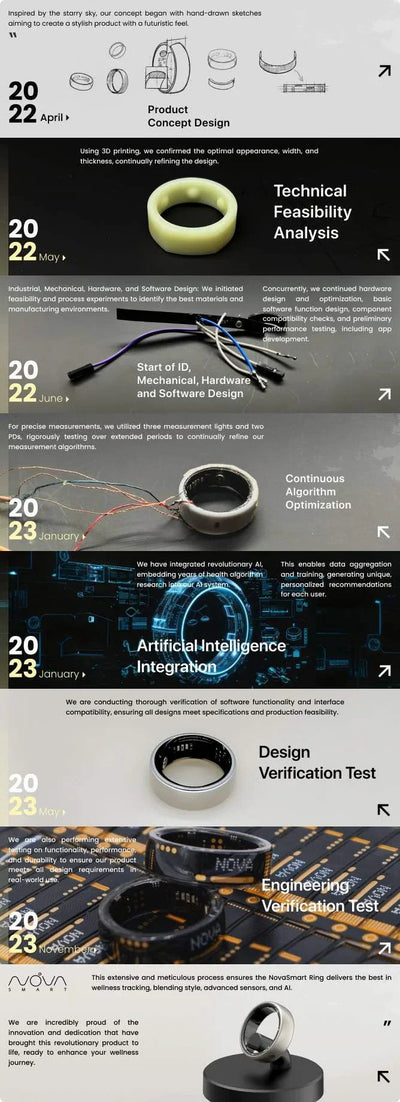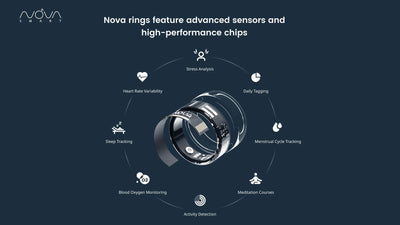Find out how a sleep tracking ring works and what technology lies behind it. Get the insights you need to optimize your nightly rest.
Sleep is often taken for granted, just a nightly pause before the next day. Yet, beneath the surface, sleep is a complex and vital biological process involving brain waves, heart rhythms, and body systems working in sync. Understanding this complexity can be challenging, but modern technology offers a practical solution. Sleep tracking rings, a type of wearable sleep tracker in the form of a (smart) ring, have become popular tools that reveal what happens during your night’s rest in remarkable detail.
In this article, we’ll explore the science behind sleep tracking rings, how they capture your sleep data, and how to interpret that information to gain better insights into your health. Whether you already use a sleep tracking ring or are curious about the technology, this guide will deepen your understanding of what makes these devices so powerful.
A Brief History of Sleep Tracking Technology
The study of sleep dates back decades, with polysomnography (PSG) standing as the clinical gold standard. PSG involves monitoring brain activity (EEG), eye movements (EOG), and muscle tone (EMG) to map detailed sleep stages. While incredibly precise, PSG requires overnight stays in specialized clinics, limiting its use to medical assessments.
Consumer sleep tracking devices first appeared in the early 2000s. These were often wristbands or under-mattress sensors aimed at measuring movement and basic sleep duration. Although innovative, these devices had limits in accuracy and comfort.
The arrival of sleep tracking rings revolutionized the field. By placing sensors on the finger, where blood vessels lie closer to the surface, these rings gather more precise biometric data without adding bulk. This breakthrough made detailed, accurate sleep monitoring accessible and comfortable for everyday use.
How Sleep Tracking Rings Capture and Process Your Sleep Data
A sleep tracking ring might look minimal, but inside is a miniature lab of biometric technology. Each component plays a specific role in analyzing your body’s signals during the night.
-
Photoplethysmography (PPG) sensors
These shine light (often infrared or green) into the skin of your finger and detect changes in light reflection caused by blood volume pulses. Because your heartbeat changes blood flow patterns, the ring can continuously measure heart rate and even heart rate variability (HRV) with high precision. Finger placement is ideal for this method because capillaries here are closer to the skin surface than at the wrist, improving signal quality.
-
Accelerometers and gyroscopes
Tiny motion sensors track how much you move during the night. Stillness often indicates deeper stages of sleep, while frequent micro-movements can suggest restlessness or awakenings. Accelerometers also help detect sleep onset and waking time by recognizing shifts in movement patterns.
-
Skin temperature sensors
Your body temperature follows a circadian rhythm, dipping during certain sleep phases. A sleep tracking ring’s temperature sensors monitor subtle changes at the skin’s surface. Spikes may indicate wakefulness or environmental disturbances (like a warm room), while steady declines often correspond with deep sleep.
-
Blood Oxygen (SpO₂) monitoring
Some rings also include red and infrared LEDs to measure oxygen saturation. This can flag patterns such as drops in oxygen during sleep, which may suggest breathing irregularities worth discussing with a healthcare provider.
-
Multi-sensor data fusion and algorithms
The raw signals from these sensors feed into proprietary algorithms that use pattern recognition to estimate sleep stages (light, deep, REM) and overall sleep quality. While consumer devices cannot fully match a clinical polysomnography (PSG) test which tracks brain waves (EEG), eye movement (EOG), and muscle tone (EMG), rings like Nova and Oura have shown strong correlations in validation studies.
Why Accuracy and Validation Matter in Sleep Tracking Rings
Not all sleep tracking rings deliver the same level of accuracy. Validating sleep ring data against the polysomnography gold standard is crucial to ensure reliable insights.
Some brands such as Oura Ring and Nova Ring rigorously test their devices using PSG data from hundreds of participants, including those with sleep disorders like obstructive sleep apnea. These studies compare ring measurements of sleep onset, wake time, and sleep stages against clinical data, providing confidence that the ring offers meaningful, trustworthy results.
Other popular wearable sleep trackers use proprietary algorithms validated to different extents. If accuracy is important to you, choosing a sleep tracking ring with solid scientific validation can make a significant difference in the usefulness of your data.
Understanding Your Sleep Data: What Does It All Mean?
Using a sleep tracking ring means gaining access to detailed information beyond just total hours slept. Common metrics include:
-
Sleep Stages: Light, deep, and REM sleep all serve unique roles in physical restoration and cognitive function. Knowing how much time you spend in each sleep stage helps assess sleep quality.
-
Sleep Score: Some apps like Oura and Nova calculate a single score based on multiple metrics, offering a quick snapshot of your overall rest.
-
Resting Heart Rate: A lower resting heart rate during sleep typically indicates better recovery and cardiovascular health.
-
Heart Rate Variability (HRV): HRV measures the variation in time between heartbeats, reflecting how well your body handles stress and recovers overnight.
Interpreting these metrics correctly can guide you in adjusting lifestyle habits like reducing caffeine intake, managing stress, or optimizing your sleep environment to improve sleep quality.
The Benefits of Using a Sleep Tracking Ring
Using a sleep tracking ring goes beyond curiosity. It offers real benefits, including:
-
Comfort and Convenience: Unlike bulkier wrist devices, sleep rings are designed for comfortable overnight wear, increasing the likelihood of consistent use.
-
Detailed, Actionable Data: Sleep rings provide nuanced insights into sleep stages and physiological patterns that wrist trackers may miss.
-
Motivation for Healthier Habits: Visualizing your sleep data often encourages better sleep hygiene, such as setting consistent bedtimes and reducing screen time before sleep.
-
Early Warning System: Some rings can detect irregularities that might indicate health problems, prompting earlier medical consultation.
Comparing Popular Sleep Tracking Rings
The market for sleep tracking rings has grown, offering several options that vary in features, design, and pricing. Here’s a quick look at some well-known models:
-
Oura Ring: Often considered the pioneer in sleep tracking rings, Oura provides detailed sleep stage analysis, readiness scores, and daily insights. It requires a monthly subscription for full app access but offers a polished user experience.
-
Nova Ring: Nova stands out for its validated accuracy against clinical data and no subscription fees. Nova's sleep tracking has been benchmarked directly against polysomnography (PSG) using data from over 400 participants, including people with obstructive sleep apnea (OSA). Its focus on usability and scientific rigor appeals to users who want reliable data without ongoing costs.
-
Galaxy Ring: Offers in-depth sleep analysis, including stages and quality scoring, alongside recovery tracking. Works especially well for users already in the Samsung ecosystem.
-
RingConn: RingConn tracks sleep and activity with decent accuracy for the price. It lacks some of the advanced features found in premium models but serves well for basic sleep monitoring.
-
Ultrahuman Ring: A newer entrant, Ultrahuman combines sleep tracking with metabolic insights, targeting users interested in a holistic health overview.
Each sleep tracking ring offers a unique balance of features and price points. When choosing, consider what’s most important for your needs, whether that’s detailed analytics, comfort, or cost-effectiveness.
Common Questions About Sleep Tracking Rings
Q: How accurate is a sleep tracking ring compared to clinical sleep studies?
A: While no consumer wearable matches the precision of polysomnography, validated sleep tracking rings have demonstrated strong correlations with clinical data, making them reliable tools for tracking trends and patterns.
Q: Can a sleep tracking ring diagnose sleep disorders?
A: Sleep tracking rings are not diagnostic tools. However, they can identify signs of potential issues like frequent awakenings or irregular heart rates, suggesting when a professional evaluation may be warranted.
Q: How often should I wear my sleep tracking ring?
A: For the most accurate long-term insights, wearing your sleep tracking ring every night is recommended. Consistent use helps reveal patterns that single nights cannot.
Q: What’s the difference between a sleep tracking ring and a wrist-based wearable?
A: Sleep tracking rings are typically smaller and more comfortable, relying on sensors placed on the finger’s blood vessels for precise readings. Wrist devices may track additional metrics but can be bulkier, less comfortable for sleep, and less accurate.
Q: Are there any health risks wearing a sleep tracking ring overnight?
A: Sleep rings are designed to be safe and non-invasive. Models made of titanium are especially light and skin-friendly. However, if you experience skin irritation or discomfort, it’s advisable to take breaks or consult with a dermatologist.
Final Thoughts: Harnessing the Science of Sleep Tracking Rings
Sleep tracking rings blend sophisticated science with everyday practicality. By accurately capturing your heart rate, movement, temperature, and more, these devices provide a comprehensive look at your sleep cycles. Understanding this data allows you to make informed changes to your routine, leading to better rest and improved overall health.
Whether you’re considering your first smart ring for sleep tracking or looking to deepen your knowledge, appreciating the science behind these devices will help you get the most from your investment. With consistent use and thoughtful interpretation, a sleep tracking ring can be an invaluable companion on your journey to better sleep.
Experience the science for yourself: discover how Nova Ring translates cutting-edge sleep tracking technology into clear, actionable insights.











